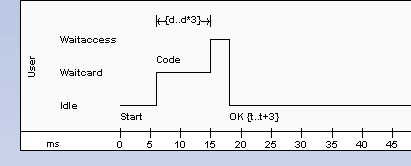
A Lifeline is the path an object takes across a measure of time, as indicated by the x-axis. There are two sorts: State Lifelines (defined here) and Value Lifelines, both used in Timing diagrams.
A State Lifeline follows discrete transitions between states, which are defined along the y-axis of the timeline. Any transition has optional attributes of timing constraints, duration constraints and observations. An example of a State Lifeline is shown below:

See UML Superstructure Specification, v2.0, figure 350, p. 452.
A State Lifeline consists of a set of transition points. Each transition point can be defined with the following properties:
Property |
Description |
At time |
Specifies the starting time for a change of state. |
Transition to |
Indicates the state to which the lifeline changes. |
Event |
Describes the occurring event. |
Timing constraints |
Refers to the time taken for a state to change within a lifeline, or the time taken to transmit a message (e.g. t..t+3). |
Timing observations |
Provides information on the time of a state change or sent message. |
Duration constraints |
Pertains to a lifeline's period at a particular state. The constraint could be instigated by a change of state within a lifeline, or that lifeline's receipt of a message. |
Duration observations |
Indicates the interval of a lifeline at a particular state, begun from a change in state or message receipt. |
In the example diagram above, the OK transition point has these properties:
Property |
Value |
At Time |
18 ms |
Transition to |
Idle |
Event |
OK |
Timing constraints |
t..t+3 |
Timing observations |
?/span> |
Duration constraints |
?/span> |
Duration observations |
?/span> |
Toolbox Icon
![]()
OMG UML Specification
The OMG UML specification (UML Superstructure Specification, v2.0, p. 451) states:
"This is the state of the classifier or attribute, or some testable condition, such as an discrete enumerable value. See also 'StateInvariant (from BasicInteractions)' on page 433.
"It is also permissable to let the state-dimension be continuous as well as discrete. This is illustrative for scenarios where certain entities undergo continuous state changes, such as temperature or density."


